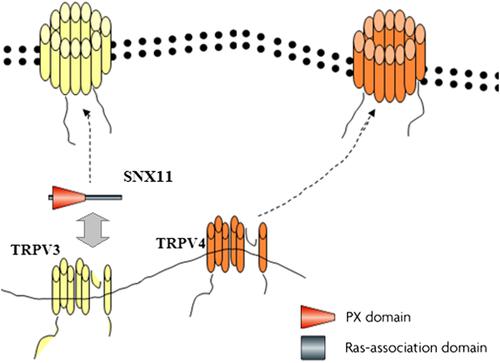当前位置:
X-MOL 学术
›
Genes Brain Behav.
›
论文详情
Our official English website, www.x-mol.net, welcomes your feedback! (Note: you will need to create a separate account there.)
Sorting nexin 11 knockout mice exhibit enhanced thermosensing behaviour.
Genes, Brain and Behavior ( IF 2.5 ) Pub Date : 2019-11-15 , DOI: 10.1111/gbb.12625 Hua-Lin Huang 1, 2, 3 , Caiyue Li 1, 2 , Wenbo Ma 1, 2 , Shikui Yin 1, 2 , Huifan Zhao 1, 2 , Sihao Deng 4 , Xiaodong Shu 1, 2 , Donghai Wu 1, 2 , Ji Li 4 , Rongqi Huang 1, 2 , Na Cheng 1, 2, 4 , Jufang Huang 4 , Zhiyuan Li 1, 2, 5
Genes, Brain and Behavior ( IF 2.5 ) Pub Date : 2019-11-15 , DOI: 10.1111/gbb.12625 Hua-Lin Huang 1, 2, 3 , Caiyue Li 1, 2 , Wenbo Ma 1, 2 , Shikui Yin 1, 2 , Huifan Zhao 1, 2 , Sihao Deng 4 , Xiaodong Shu 1, 2 , Donghai Wu 1, 2 , Ji Li 4 , Rongqi Huang 1, 2 , Na Cheng 1, 2, 4 , Jufang Huang 4 , Zhiyuan Li 1, 2, 5
Affiliation

|
Temperature sensing is an important adaptive mechanism for warm‐blooded animals such as humans. ThermoTRP ion channels are activated by distinct but overlapping physiological temperatures. Our previous research demonstrated that sorting nexin 11 (SNX11) regulates lysosomal degradation of plasma membrane TRPV3, one of ThermoTRP ion channel proteins. Here, we found that SNX11, a vesicular trafficking protein, modulates mouse behaviour in response to temperature changes. Snx11‐knockout mice exhibit a stronger preference for mild temperatures along with enhanced sensitivity to harmful heat. Mechanistically, keratinocytes from Snx11‐knockout mice exhibit a larger temperature‐gated TRPV3 membrane current and have enhanced thermoTRPV3 expression in the plasma membrane compared to wild‐type keratinocytes. Additionally, Snx11‐knockout mice show higher endogenous TRPV3 protein levels in skin tissues than wild‐type mice do. Therefore, our results indicate that SNX11 may regulate thermal perception via alteration of functional thermoTRPV3 on the plasma membrane of thermally sensitive cells, which is the first link between vesicular trafficking and thermal transduction.
中文翻译:

分类nexin 11基因敲除小鼠表现出增强的热敏行为。
温度感测是人类等温血动物的重要适应机制。ThermoTRP离子通道被独特但重叠的生理温度激活。我们先前的研究表明,分选神经毒素11(SNX11)调节质膜TRPV3的溶酶体降解,TRPV3是ThermoTRP离子通道蛋白之一。在这里,我们发现SNX11是一种水泡运输蛋白,可调节小鼠的行为以响应温度变化。Snx11基因敲除小鼠对温和的温度表现出更大的偏爱,并增强了对有害热量的敏感性。从机理上讲,来自Snx11的角质形成细胞与野生型角质形成细胞相比,基因敲除小鼠表现出更大的温度门控TRPV3膜电流,并且在质膜中具有增强的thermoTRPV3表达。此外,与野生型小鼠相比,Snx11基因敲除小鼠在皮肤组织中显示出更高的内源性TRPV3蛋白水平。因此,我们的结果表明,SNX11可能通过热敏感细胞质膜上功能性thermoTRPV3的改变来调节热知觉,这是水泡运输与热传导之间的第一个联系。
更新日期:2019-11-15
中文翻译:

分类nexin 11基因敲除小鼠表现出增强的热敏行为。
温度感测是人类等温血动物的重要适应机制。ThermoTRP离子通道被独特但重叠的生理温度激活。我们先前的研究表明,分选神经毒素11(SNX11)调节质膜TRPV3的溶酶体降解,TRPV3是ThermoTRP离子通道蛋白之一。在这里,我们发现SNX11是一种水泡运输蛋白,可调节小鼠的行为以响应温度变化。Snx11基因敲除小鼠对温和的温度表现出更大的偏爱,并增强了对有害热量的敏感性。从机理上讲,来自Snx11的角质形成细胞与野生型角质形成细胞相比,基因敲除小鼠表现出更大的温度门控TRPV3膜电流,并且在质膜中具有增强的thermoTRPV3表达。此外,与野生型小鼠相比,Snx11基因敲除小鼠在皮肤组织中显示出更高的内源性TRPV3蛋白水平。因此,我们的结果表明,SNX11可能通过热敏感细胞质膜上功能性thermoTRPV3的改变来调节热知觉,这是水泡运输与热传导之间的第一个联系。


























 京公网安备 11010802027423号
京公网安备 11010802027423号